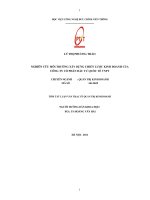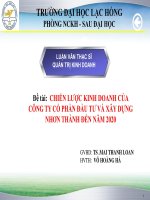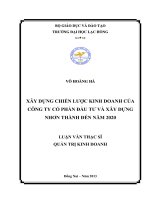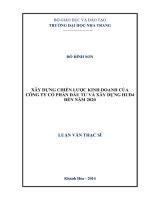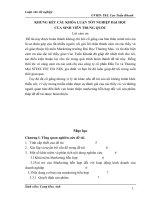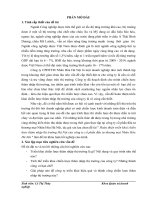Chiến lược phát triển của công ty cổ phần đầu tư và phát triển nhà hà nội – HANDICO giai đoạn 2015 2020
Bạn đang xem bản rút gọn của tài liệu. Xem và tải ngay bản đầy đủ của tài liệu tại đây (733.63 KB, 110 trang )
LUẬN VĂN THẠC SĨ
Chiến lược phát triển của công ty cổ phần đầu tư và phát triển Nhà Hà nội –
HANDICO giai đoạn 2015-2020
THESIS MBA
DEVELOPMENT STRATEGY FOR HANOI HOUSING
DEVELOPMENT AND INVESTMENT CORPORATION
(HANDICO) DURING THE PERIOD OF 2015-2020
1
ACKNOWLEDGMENT
After a period of time participating at the International management of
business administration jointly organized by Hanoi National University and Griggs
University (USA), members of our group have acquired the most advanced
knowledge in the world in business management. With the teaching method and
issue raising method,… of domestic and foreign lecturers, we have been equipped
with a scientific way of thinking in order to research on new knowledge in various
fields concerning business administration in the future.
Our group’s Capstone project is a fine combination between the knowledge
transferred from our professors and the practice that we ourselves have experienced.
Due to time limit, the knowledge we have is still at a reasonable level, so our
capstone project may have some shortcomings. We wish to receive contributing
ideas from our professors and scientific council so as to further complete our
project.
We sincerely thank our lecturers, tutors and the entire staff of ETC Center
for their enthusiasm and their assistance to create favorable conditions throughout
the course. We also wish to express our thanks to all the students of
GaMBA01.M03 who have strongly been united and helping one another during the
time of studying and researching.
We would like to thank members of the Board of the Council, Board of
Directors and all office staff of Hanoi Housing Development and Investment
Corporation who have helped us collect data for analysis in our capstone project.
Thank you very much!
Hanoi, December 2009
2
CONTENT
CHAPTER 1: THEORIES OF MANAGEMENT STRATEGY........................12
1.1/ OVERALL ABOUT STRATEGY AND STRATEGIC MANAGEMENT:.....12
1.1.1/ The concept of strategy and strategic management:........................................12
1.1.2/ The benefit of management strategy................................................................14
1.2/ CONTENT OF MANAGEMENT STRATEGY:..............................................15
1.2.1/ The Business Vision and Company Mission Statement.................................16
1.2.2 External environment analysis:........................................................................17
1.2.2.1 Macro environment analysis:..............................................................17
1.2.2.2/ Industry environment analysis :........................................................18
1.2.3/ Internal environment analysis :........................................................................22
Understanding a business in depth is the goal of internal analysis. This analysis is
based resources and capabilities of the firm..............................................................23
1.3/ FORMULATION AND SELECTION OF DEVELOPMENT STRATEGIES 25
1.3.1/ Strategy formulation:.......................................................................................25
1.3.1.1/ Identifying objective and the importance of identifying objective:..25
1.3.1.2/ SWOT matrix and choosing business strategy:................................26
1.3.2/ Selecting the best strategy:...............................................................................27
1.3.2.1/ Cost Leadership Strategy ..................................................................28
1.4/ CONCLUSION:..................................................................................................33
CHAPTER II: ANALYSIS OF ACTUAL SITUATION OF HANOI HOUSING
DEVELOPMENT AND INVESTMENT CORPORATION (HANDICO)
...33
2.1/ EXTERNAL ENVIRONMENT ANALYSIS:...................................................33
2.1.1 Macro environment analysis:............................................................................33
2.1.1.1/ Political - legal environment: (P).......................................................34
2.1.1.2/ Economic environment: (E)...............................................................36
2.1.1.3/ Social environment: (S).....................................................................37
2.1.1.4/ Technology environment: (T)............................................................38
2.1.1.5/ International environment:.................................................................39
3
2.1.2. Industry environment analysis:........................................................................39
2.1.2.1/ Potential entrants:...............................................................................40
2.1.2.2/ Existing competitors:.........................................................................42
2.1.2.3/ Bargaining power of buyers:.............................................................42
2.1.2.4/ Bargaining power of suppliers:..........................................................44
2.1.2.5/ Threat of substitutes:..........................................................................45
2.1.3. Summing up results of external environment analysis:...................................45
2.1.3.1/ Opportunities and ranking opportunities: ........................................46
2.1.3.2/ Threats and ranking threats:...............................................................48
2.2/ INTERNAL ENVIRONMENT ANALYSIS:....................................................50
2.2.1/ Overview about HANDICO:...........................................................................50
2.2.1.1/ The process of establishment and development of HANDICO:.......50
2.2.1.2/ HANDICO’s organizational structure and management mechanism:
.........................................................................................................................54
2.2.1.3/ Main business activities of HANDICO:............................................55
2.2.1.4/ Mission, vision and value of HANDICO:.........................................57
2.2.2/ Analysis of production and trade results from 2006-2008..............................58
2.2.3/ Analysis of internal environment of HANDICO : ........................................59
2.2.3.1/ Capacity in terms of equipment, infrastructure: ..............................59
2.2.3.2/ Experience in operating and being master of technology:................61
2.2.3.3/ Production cost management and main material management.........61
2.2.3.4/ Production quality:.............................................................................62
2.2.3.5/ Management team:.............................................................................64
2.2.3.6/ Strength in human resources:.............................................................65
2.2.3.7/ Management system for production and business activities.............66
2.2.3.8/ Works sourcing, selling and marketing.............................................67
2.2.3.9/ After-sales service:.............................................................................68
2.2.3.10/ Analysis of selling price of products:..............................................68
2.2.3.11/ Research and development..............................................................71
2.2.4/ Identifying outstanding capability and competitive edges..............................71
4
2.2.4.1/ Identifying outstanding capability:....................................................71
2.2.4.2/ Identifying HANDICO’s stable competitive edges: .......................76
2.2.5/ Summing up internal environment analysis for HANDICO .........................77
CHAPTER III–FORMULATION AND SELECTION OF DEVELOPMENT
STRATEGIES FOR HANDICO. STRATEGIC SOLUTIONS AND
IMPLEMENTATION PLAN...............................................................................78
3.1/ FORMING BUSINESS STRATEGIES AND SELECTING THE BEST
STRATEGY FOR HANDICO .................................................................................78
3.1.1. SWOT analysis:................................................................................................78
3.1.2. Selecting the best strategy for HANDICO:.....................................................82
3.2/ COST LEADERSHIP STRATEGY:..................................................................84
3.2.1/ Content of strategy:..........................................................................................84
3.2.1.1/ Short-term goals till 2015:.................................................................84
3.2.1.2 Long-term goals:.................................................................................85
3.2.2/ Strategic solutions:...........................................................................................86
3.2.3/ Implementation plan:.......................................................................................89
3.3/ STRATEGY OF FOCUSING INTO KEY CLIENTS .....................................93
3.3.1/ Content of strategy: .........................................................................................93
3.3.1.1/ Short-term goals till 2015:.................................................................93
3.3.1.2/ Long-term goals:................................................................................94
3.3.2/ Strategic solutions:...........................................................................................95
3.3.3/ Implementation plan:.......................................................................................96
3.4/ SHORT-COMINGS OF CAPSTONE PROJECT:..........................................100
3.5/ DIRECTION FOR FOLLOW-UP RESEARCH:.............................................100
CONCLUSION....................................................................................................102
REFERENCE DOCUMENTS............................................................................104
ANNEX 1.............................................................................................................. 106
ANNEX 2.............................................................................................................. 108
5
LIST OF FIGURES
Figure 1.1/ M.Porter ‘s 5-force competitive model.............................................19
Figure 2.1/ PEST analysis.....................................................................................34
Figure 2.2/ Forecast of GDP growth of some regions, nations in 2009 and 2010
in comparison with the growth of recent years...................................................37
Figure 2.3/ M.Porter ‘s 5-force competitive model.............................................40
Figure 2.4/ Evaluation of opportunities for HANDICO ...................................46
Firgure 2.5/ Evalutating impact of threats to HANDICO ................................48
Figure 2.6/ Summing up opportunities and threats for HANDICO ................50
Figure 2.7/ Criteria and achievement during 2004-2008....................................53
Figure 2.8/ HANDICO’s chartered capital through various years....................53
Figure 2.9/ HANDICO’s organization chart:......................................................54
Figure 2.10/ HANDICO’s labor structure up to 31/8/2009:...............................55
Figure 2.11/ HANDICO production and trade results from 2006 - 2008..........58
Figure 2.12/ Main equipmnet of HANDICO.......................................................59
Figure 2.13/ Typical constructions and projects implemented by HANDICO. 63
Figure 2.14/ Typical constructions that HANDICO has won tender.................69
Figure 2.15/ Main information about competitors..............................................72
Figure 2.16/ Table of opinions of experts ...........................................................75
Figure 2.17/ Table of opinions of internal survey in HANDICO.......................76
Figure 2.18/ Table of relationship in terms of HANDICO’s competitive edges
................................................................................................................................. 77
Figure 2.19/ Summing up strengths and weaknesses of HANDICO..................78
Figure 3.1/ Overall SWOT matrix for HANDICO:............................................79
Figure 3.2/ GREAT model for choosing the optimum strategy for HANDICO
................................................................................................................................. 83
Figure 3.3/ Implementation plan for cost leadership strategy ..........................90
Figure 3.4/ Implementation plan for strategy of focusing into key clients ......97
6
ABBREVIATIONS
ASEAN
Association of Southeast Asian Nations
APEC
Asia – Pacific Economic Forum
GDP
Gross Domestic Products
FDI
Foreign Direct Invention
GREAT
Gains – Risks – Expenses – Achievability – Timing
HANDICO
Hanoi Housing Development and Investment Corporation
PEST
Politics, Economy, Society, Technology
PR
Public Relation
R&D
Research & Development
SWOT
Strength, Weakness, Opportunity, Threat
SO
Strategy for combining Strengths & Opportunities)
ST
Strategy for combining Strengths & Threat
WO
Strategy for combining Weaknesses & Opportunities
WT
Strategy for combining Weaknesses & Threat)
WTO
World Trade Organization
Corporation
Hanoi Housing Development and Investment Corporation
7
FOREWORDS
1. The Capstone Project Title: Development strategy for Hanoi Housing
Development and Investment Corporation (HANDICO) during the period of
2015-2020:
2. The reason for choosing the Project:
During recent time, the world economy has experienced great changes;
especially the financial crisis in the US has affected almost all the nations in the
world including Vietnam.
After this economic crisis, we now can look back to find out the internal
shortcomings and weaknesses of our economy. At present, the Vietnamese
economy in particular and the world economy in general tend to start recovering
and developing. It is important that each economic organization must find out a
suitable direction for its own to enable the stable development in the future.
Vietnam has been regarded as an economy with rather fast economic recovery,
which has been shown by the Government’s rescue packages to stimulate economic
growth. However, an undeniable fact is that the Vietnamese economy is growing at
a lower level than its potential due to major obstacles including inefficient
investment, dilapidated infrastructure and a merely economy of semi-fabrication
with low added value. From the 3rd quarter of 2007, domestic enterprises had to
overcome the fiercest screening stage. After this screening stage, the enterprises that
still survive and develop have proven their high adaptability, agility and flexibility
in their business and production activities.
For developing countries, construction is always considered one of the key
industries, which plays an important role in the economic-social development
8
course, especially during the industrialization and modernization of the country. It
creates basic physical facilities for the stable development in the future.
At present, Vietnam is actively implementing administrative improvement
measurements to create a fair legal and investment environment in order to
encourage and attract domestic and foreign investors.
However, investors also have to face with and abide by the rules of the game in
which they have their real rivals, there is no concession or sharing, and it is a fierce,
risky and challenging battle.
The rule of competition does not give exception to any economic entity or
sector in the society and this rule exists in all fields. Therefore, economic sectors in
general and construction in particular have to find their own way, build their own
specific and suitable strategies and tactics for survival and development.
Hanoi Housing Development and Investment Corporation (HANDICO) is a state
owned enterprise founded on September 21 st, 1999 under the first “Corporation 90”
model of Hanoi. In the context that the economy is shifting towards the socialismoriented economy, the foundation of HANDICO had an important meaning in terms
of arranging, splitting the enterprise-managing function of Bureaus, Departments,
district authorities, focusing into the establishment of big and official economic
organization operating in the fields of construction, as well as implementing other
important responsibilities assigned by the municipality, meeting the demand of
innovation in the business of housing development of the Capital in the modern
society.
The most important thing for HANDICO now is to work out an overall
development plan for all its production and business activities in order to compete
with domestic and foreign enterprises and to enlarge market share so as to achieve
its growth target in all aspects during the period of 2010-2015. This is also the
target of the writers when choosing this strategic planning topic.
3. Purpose and scope of research:
9
Researching the basis for setting up development strategy, strategy process and
the way to select the optimum strategy in order to help HANDICO identify a
suitable strategy of production and business in the current business circumstance.
From there, HANDICO can take on proper actions for expanding, reducing business
cost, using capital effectively, having profit as well as enhancing the
competitiveness for the enterprise.
From the above-mentioned research, putting forth proposals for solutions to
improve the process of building up HANDICO’s strategy in the current business
circumstance.
Scope of research: This capstone project focuses into analyzing the strengths and
weaknesses of HANDICO’s current strategy. From that basis, building up and
selecting business strategy for HANDICO during the period of 2010-2015.
4. Implementation method:
Qualitative method: Applying theories of business strategy, bringing the models
of business strategy setting up and selecting into the practical situation of
HANDICO.
Research methodology: Statistics, survey, analysis, comparison, synthesizing
data.
Data: Primary and secondary.
Data collecting method: Depending on data publicized on mass media and
HANDICO’s capability portfolio.
5. Structure of capstone project:
The capstone project consists of forewords and 3 chapters. The main content of
each chapter is presented as follow:
CHAPTER 1: THEORIES OF MANAGEMENT STRATEGY
- Overall about strategy and strategic management .
10
- Content of management strategy.
- Formulation and selection of development strategies.
- Conclusion.
CHAPTER II: ANALYSIS OF ACTUAL SITUATION OF HANOI HOUSING
DEVELOPMENT AND INVESTMENT CORPORATION
- External environment analysis
- Internal environment analysis
-
CHAPTER III: FORMULATION ANDSELECTION OF DEVELOPMENT
STRATEGIES FOR HANDICO.
STRATEGIC SOLUTION AND IMPLEMENTATION PLAN
- Forming business strategies and selecting the best strategy for HANDICO
-
Cost leadership strategy
-
Strategy of focusing into key clients
-
Short-comings of capstone project
-
Direction for follow-up research
CONCLUSION
11
CHAPTER 1: THEORIES OF MANAGEMENT STRATEGY
1.1/ OVERALL ABOUT STRATEGY AND STRATEGIC MANAGEMENT:
1.1.1/ The concept of strategy and strategic management:
Strategy
Strategy is the mean or the tool by which objectives are consciously and
systematically pursued and obtained over time. The word “strategy” derives from
the Greek word stratçgos; which derives from two words: - "stratos" – meaning
army and "ago" – which is the ancient Greek for leading/guiding/moving.
Strategy is distinct from tactics. In military terms, tactics is concerned with
the conduct of an engagement while strategy is concerned with how different
engagements are linked. In other words, how a battle is fought is a matter of tactics:
the terms that it is fought on and whether it should be fought at all is a matter of
strategy.
Johnson and Scholes (Exploring Corporate Strategy) define strategy as
follows:
"Strategy is the direction and scope of an organization over the long-term:
which achieves advantage for the organization through its configuration of
resources within a challenging environment, to meet the needs of markets and to
fulfill stakeholder expectations".
In other words, strategy is about:
• Where is the business trying to get to in the long-term (direction)
• Which markets should a business compete in and what kind of activities
is involved in such markets? (markets; scope)
12
• How can the business perform better than the competition in those
markets? (advantage)?
• What
resources
(skills,
assets,
finance,
relationships,
technical
competence, and facilities) are required in order to be able to compete?
(resources)?
• What external, environmental factors affect the businesses' ability to
compete? (environment)?
• What are the values and expectations of those who have power in and
around the business? (stakeholders)
Strategy at Different Levels of a Business
Strategies exist at several levels in any organization - ranging from the
overall business (or group of businesses) through to individuals working in it.
Corporate Strategy - is concerned with the overall purpose and scope of the
business to meet stakeholder expectations. This is a crucial level since it is heavily
influenced by investors in the business and acts to guide strategic decision-making
throughout the business. Corporate strategy is often stated explicitly in a "mission
statement".
Business Unit Strategy - is concerned more with how a business competes
successfully in a particular market. It concerns strategic decisions about choice of
products, meeting needs of customers, gaining advantage over competitors,
exploiting or creating new opportunities etc.
Operational Strategy - is concerned with how each part of the business is
organized to deliver the corporate and business-unit level strategic direction.
Operational strategy therefore focuses on issues of resources, processes, people etc.
How Strategy is Managed - Strategic Management
13
In its broadest sense, strategic management is about taking "strategic
decisions" - decisions that answer the questions above.
In practice, a thorough strategic management process has three main
components, shown in the figure below:
1.1.2/ The benefit of management strategy
Studies show that if applied management strategies organizations will
perform better than organizations do not perform this process. Achieved if
appropriate between environmental organization's strategy, structure and process
will generate positive effects on the performance of the organization. Benefits of
management strategy have been tested in many different fields, can be short with
the three most basic are:
• Develop clear strategic scenario for the company
• Focusing more precisely on the important strategy
• Improve awareness of the rapidly changing environment
However, to achieve effective management strategies always need a formal
process and it can start with questions:
• Where is the organization?
• If no changes are be made after 1 year, 2 years, 3 years, 5 years, 10 years,
will it be acceptable or not ?
14
• If the answer is not acceptable, is it necessary to implement specific
management actions? What should be considered as risks and interests?
1.2/ CONTENT OF MANAGEMENT STRATEGY:
In the 1970's, many large firms adopted a formalized top-down strategic
planning model. Under this model, strategic planning became a deliberate process
in which top executives periodically would formulate the firm's strategy, and then
communicate it down the organization for implementation. The following is a
flowchart model of this process:
The Strategic Planning Process
Mission
|
V
Objectives
|
V
Situation Analysis
|
V
Strategy Formulation
|
V
Strategy Selection
|
V
Implementation
This process is most applicable to strategic management at the business unit
level of the organization. For large corporations, strategy at the corporate level is
15
more concerned with managing a portfolio of businesses. For example, corporate
level strategy involves decisions about which business units to grow, resource
allocation among the business units, taking advantage of synergies among the
business units, and mergers and acquisitions. In the process outlined here,
"company" or "firm" will be used to denote a single-business firm or a single
business unit of a diversified firm.
1.2.1/ The Business Vision and Company Mission Statement
- Vision
Statement to open a mission for the plan and strategy is the foundation for a
vision of the company. Statement of mission or may be a motivating employees
when transmit the purpose and value of the company to customers and
communities.
A statement of vision is a report about a company where you hope to
achieve. Universal Declaration vision needed for strategic planning because it
outlines the future of your company as you achieve goals and your goals. The
statement of vision may be different between different lengths, can be a short, can
be a paragraph long, but must identify the final destination of you.
Vision of your company is an important statement to guide the process of
planning strategies. A statement of vision will determine the best results for the
current initiatives and your potential.
- Mission:
Mission is to answer the question why? Mission will be the business and will
lose the business no longer exists or switch to a business other.
Statement of mission is a documentation purposes inform the existence of
your company. A mission statement identifies the values and rules governed by
your company and is a dominant part in the planning strategy. The mission may be
different in length, can be from 1 to 1 of questions and should talk about business,
16
purpose and values. Mission of the company which is why the company exists on
the market, who you are and you will bring to customers and communities in these
types of products and services do. Decisions in the process of planning and strategy
of the dominant company must always harmonious with the statement of mission.
A strategic plan starts with a clearly defined business mission. Mintzberg
defines a mission as follows: “A mission describes the organization’s basic
function in society, in terms of the products and services it produces for its
customers”.
1.2.2 External environment analysis:
1.2.2.1 Macro environment analysis:
A scan of the external macro-environment in which the firm operates can be
expressed in terms of the following factors:
•
Political
•
Economic
•
Social
•
Technological
Political Factors :
Political factors include government regulations and legal issues and define
both formal and informal rules under which the firm must operate. Some examples
include:
•
tax policy
•
employment laws
•
environmental regulations
•
trade restrictions and tariffs
•
political stability
17
Economic Factors
Economic factors affect the purchasing power of potential customers and the
firm's cost of capital. The following are examples of factors in the macro economy:
•
economic growth
•
interest rates
•
exchange rates
•
inflation rate
Social Factors
Social factors include the demographic and cultural aspects of the external
macro environment. These factors affect customer needs and the size of potential
markets. Some social factors include:
•
health consciousness
•
population growth rate
•
age distribution
•
career attitudes
•
emphasis on safety
Technological Factors
Technological factors can lower barriers to entry, reduce minimum efficient
production levels, and influence outsourcing decisions. Some technological factors
include:
•
R&D activity
•
automation
•
technology incentives
•
rate of technological change
1.2.2.2/ Industry environment analysis :
18
Figure 1.1/ M.Porter ‘s 5-force competitive model
New entrants
Threat of new
entrance
Industry competitors
Suppli
ers
Bargaining
power of
suppliers
Buyers
Distributors
Bargaining
power of
buyers
Threats of substitutes
Intensity of rivalry
Substitutes
(Source : Michael Porter, "Competitive Strategy: Techmques Analyzing Industries and
Competitors)
Porter (1980) argues that five forces determine the profitability of an industry. They
are featured in Figure 1.1. At the heart of the industry are rivals and their
competitive strategies linked to, say, pricing or advertising; but, he contends, it is
important to look beyond one’s immediate competitors as there are other
determinants of profitability. Specifically there might be competition from
substitute products or services. These alternatives may be perceived as substitutes
by buyers even though they are part of a different industry. There may also be a
potential threat of new entrants, although some competitors will see this as an
opportunity to strengthen their position in the market by ensuring, as far as they can,
customer loyalty. Finally it is important to appreciate that companies purchase from
suppliers and sell to buyers. If they are powerful they are in a position to bargain
profits away through reduced margins, by forcing either cost increases or price
decreases. This relates to the strategic option of vertical integration which will be
considered in detail later in the book. Vertical integration occurs where a company
acquires, or merges with, a supplier or customer and thereby gains greater control
over the chain of activities which leads from basic materials through to final
consumption.
19
Any company must seek to understand the nature of its competitive
environment if it is to be successful in achieving its objectives and in establishing
appropriate strategies. If a company fully understands the nature of the five forces,
and particularly appreciates which one is the most important, it will be in a stronger
position to defend itself against any threats and to influence the forces with its
strategy. The situation, of course, is fluid, and the nature and relative power of the
forces will change. Consequently, the need to monitor and stay aware is continuous.
An industry is a group of firms that market products which are close
substitutes for each other (e.g. the car industry, the travel industry).
Some industries are more profitable than others. Why? The answer lies in
understanding the dynamics of competitive structure in an industry.
The most influential analytical model for assessing the nature of competition
in an industry is Michael Porter's Five Forces Model, which is described below:
Porter explains that there are five forces that determine industry
attractiveness and long-run industry profitability. These five "competitive forces"
are:
- The threat of entry of new competitors (new entrants)
- The threat of substitutes
- The bargaining power of buyers
- The bargaining power of suppliers
- The degree of rivalry between existing competitors
Threat of New Entrants
New entrants to an industry can raise the level of competition, thereby
reducing its attractiveness. The threat of new entrants largely depends on the
20
barriers to entry. High entry barriers exist in some industries (e.g. shipbuilding)
whereas other industries are very easy to enter (e.g. estate agency, restaurants). Key
barriers to entry include
- Economies of scale
- Capital / investment requirements
- Customer switching costs
- Access to industry distribution channels
- The likelihood of retaliation from existing industry players.
Threat of Substitutes
The presence of substitute products can lower industry attractiveness and
profitability because they limit price levels. The threat of substitute products
depends on:
- Buyers' willingness to substitute
- The relative price and performance of substitutes
- The costs of switching to substitutes
Bargaining Power of Suppliers
Suppliers are the businesses that supply materials & other products into the
industry.
The cost of items bought from suppliers (e.g. raw materials, components) can
have a significant impact on a company's profitability. If suppliers have high
bargaining power over a company, then in theory the company's industry is less
attractive. The bargaining power of suppliers will be high when:
- There are many buyers and few dominant suppliers
- There are undifferentiated, highly valued products
- Suppliers threaten to integrate forward into the industry (e.g. brand
manufacturers threatening to set up their own retail outlets)
- Buyers do not threaten to integrate backwards into supply
21
- The industry is not a key customer group to the suppliers
Bargaining Power of Buyers
Buyers are the people / organizations who create demand in an industry
The bargaining power of buyers is greater when
- There are few dominant buyers and many sellers in the industry
- Products are standardized
- Buyers threaten to integrate backward into the industry
- Suppliers do not threaten to integrate forward into the buyer's industry
- The industry is not a key supplying group for buyers
Intensity of Rivalry
The intensity of rivalry between competitors in an industry will depend on:
- The structure of competition - for example, rivalry is more intense
where there are many small or equally sized competitors; rivalry is less when an
industry has a clear market leader
- The structure of industry costs - for example, industries with high fixed
costs encourage competitors to fill unused capacity by price cutting
- Degree of differentiation - industries where products are commodities
(e.g. steel, coal) have greater rivalry; industries where competitors can differentiate
their products have less rivalry
- Switching costs - rivalry is reduced where buyers have high switching
costs - i.e. there is a significant cost associated with the decision to buy a product
from an alternative supplier
- Strategic objectives - when competitors are pursuing aggressive growth
strategies, rivalry is more intense. Where competitors are "milking" profits in a
mature industry, the degree of rivalry is less
- Exit barriers - when barriers to leaving an industry are high (e.g. the cost
of closing down factories) - then competitors tend to exhibit greater rivalry.
1.2.3/ Internal environment analysis :
22
Understanding a business in depth is the goal of internal analysis. This analysis is
based resources and capabilities of the firm.
Resources
A good starting point to identify company resources is to look at tangible, intangible
and human resources.
Tangible resources are the easiest to identify and evaluate: financial resources and
physical assets are identifies and valued in the firm’s financial statements.
Intangible resources are largely invisible, but over time become more important to
the firm than tangible assets because they can be a main source for a competitive
advantage. Such intangible recourses include reputational assets (brands, image,
etc.) and technological assets (proprietary technology and know-how).
Human resources or human capital are the productive services human beings offer
the firm in terms of their skills, knowledge, reasoning, and decision-making
abilities.
RESOURCE
MAIN CHARACTERISTICS
KEY INDICATOR
Tangible
Financial
The firm’s borrowing capacity, and
its internal funds generation
determine its capacity to weather
fluctuations in demand and profits
overtime.
Physical
The physical resources related to
plant, equipment, assets,
technology, raw materials.
Intangible
Technological
Stock of technology in the form of
proprietary technology (copy right,
patents, trade secrets) and expertise
23
•
•
Debt to equity ratio
Ration of net cash
to capital expenses
• Credit rating
• (WE need different
ones)
•
Resale value of
assets
• Age of capital
equipment
• Flexibility of PPE
in the application of technology
(know-how).
Reputation
Human
Resources
Reputation with customers through
the ownership of brands,
established relationships with
customers, reputation of the firm’s
products and services.
Reputation of the company with
suppliers, employees, govermment
and the community.
The training and expertise of
employees determine the skills
available to the firm.
The adaptability of employees
determine key aspects of strategic
flexibility of the firm.
The commitment and loyalty of
employees determines the capacity
of the firm to attain and maint ain
competitive advantage.
•
•
•
•
•
•
•
•
Brand recognition
Price premium over
competing brands
Percent of repeat
buying
Level and
consistency of
company
performance
Educational,
technical, and
professionnal
qualifications of
employees
Compensation
relative to industry
Record of labor
disputes
Employee turnover
Capabilities
Resources are not productive on their own. The most productive tasks require that
resources collaborate closely together within teams. The term “organizational
capabilities” is used to refer to a firm’s capacity for undertaking a particular
productive activity. Our interest is not in capabilities per se, but in capabilities
relative to other firms. To identify the firm’s capabilities we will use the functional
classification approach. A functional classification identifies organizational
capabilities in relation to each of the principal functional areas.
FUNCTIONAL AREA
Corpolate
CAPABILITY
Financial management
Expertise in strategic control
Effectiveness in motivating and coordinating
business units
24
Information Management
Research and Development
Management of partnerships
Overall company
management/resource management
Comprehensive and effective information system
that can be used for managerial decision making
Capability in basic research
Innovation of new products
Manufacturing
Product Design
Design capability
Marketing
Brand management and promotion
Promotion and exploiting reputation for quality
Understand of and responsiveness to market
trends
Effectiveness in promoting and executing sales
Efficiency and speed of fulfillment
Quality and effectiveness of customer service
Sales and Fulfillment
1.3/
FORMULATION
AND
SELECTION
OF
DEVELOPMENT
STRATEGIES
1.3.1/ Strategy formulation:
1.3.1.1/ Identifying objective and the importance of identifying objective:
Objective is specific, clear, feasible, in a shorter time. Objective is regarded
as a specific vision of the enterprise.
Main goal is the future status of the company trying to implement or final
results of the actions planned.
To that, the objective must have four characteristics:
- First, a target is considered to be well established if it accurate and can
measure
- Second, a target is set to be the critical issues
- Third, a goal was set up well to the challenges and can make
25

